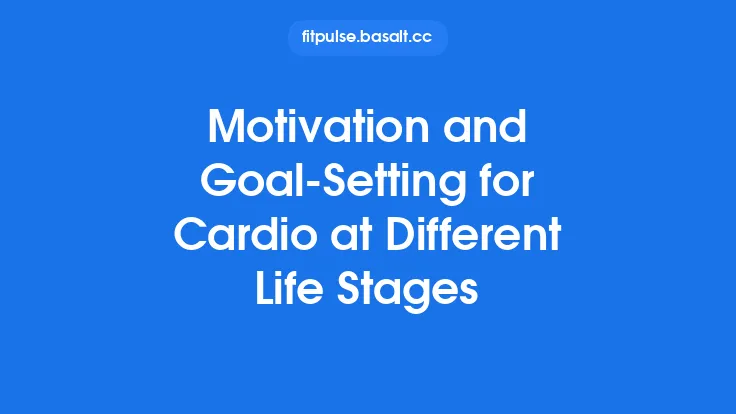Sustaining a fitness routine is often more challenging than starting one. While the initial surge of enthusiasm can carry a newcomer through the first few workouts, long‑term adherence hinges on a complex interplay of motivation, accountability, and habit formation. Recent advances in artificial intelligence have given coaches and developers new tools to reinforce these psychological levers, turning fleeting intentions into lasting behaviors. By embedding AI‑driven motivation and accountability systems into everyday fitness experiences, users can receive timely nudges, personalized reinforcement, and data‑backed insights that keep them moving forward even when intrinsic drive wanes.
The Psychology of Habit Formation and Its Relevance to Fitness
Understanding why habits stick is the foundation for any technology that aims to support them. The habit loop—cue, routine, reward—described by behavioral scientists outlines three essential components:
- Cue (Trigger): An environmental or internal signal that initiates the behavior.
- Routine (Behavior): The action performed in response to the cue.
- Reward (Outcome): The positive reinforcement that consolidates the loop in memory.
When this loop is repeated consistently, the brain’s basal ganglia begin to automate the behavior, reducing the need for conscious decision‑making. In fitness, cues can be as simple as a calendar reminder, a smartwatch vibration, or a specific time of day. Rewards may range from the physiological “runner’s high” to extrinsic points, badges, or social recognition. AI systems excel at detecting, optimizing, and reinforcing each element of this loop, making them ideal partners for habit cultivation.
AI‑Powered Cue Management: Timing, Context, and Personalization
A core challenge in habit formation is delivering cues at the right moment and in the right context. Traditional reminder apps rely on static schedules, which often clash with real‑world variability (e.g., unexpected meetings, travel). AI addresses this by:
- Dynamic Scheduling Algorithms: Machine‑learning models ingest calendar data, location history, and physiological signals (heart‑rate variability, sleep quality) to predict windows of high receptivity. For instance, a reinforcement‑learning agent may learn that a user is more likely to accept a workout prompt after a 30‑minute commute rather than during a morning meeting.
- Contextual Awareness via Sensor Fusion: By combining data from accelerometers, GPS, and ambient light sensors, AI can infer whether a user is at the gym, at home, or outdoors, and tailor cues accordingly. A “ready‑to‑run” cue might only fire when the user is near a park and the weather is favorable.
- Adaptive Frequency Control: Over‑notification can lead to fatigue. Predictive models monitor user response rates and adjust the cadence of prompts, ensuring that cues remain salient without becoming intrusive.
These capabilities transform a simple alarm into a nuanced, context‑aware nudge that aligns with the user’s daily rhythm.
Personalized Reward Systems: From Gamification to Intrinsic Reinforcement
Rewards are the glue that binds the habit loop. AI can craft both extrinsic and intrinsic reward structures that evolve with the user’s progress:
- Gamified Progression Trees: Using Bayesian inference, the system estimates a user’s skill level and confidence, then unlocks challenges that are just beyond the current capability—a principle known as the “zone of proximal development.” This keeps the experience challenging enough to be rewarding but not so difficult that it triggers disengagement.
- Dynamic Point Valuation: Traditional point systems assign static values to activities (e.g., 10 points per mile). AI recalibrates point values based on recent performance trends, effort intensity, and even mood indicators derived from voice or text sentiment analysis. A hard‑earned workout after a stressful day may be worth more points, reinforcing resilience.
- Intrinsic Feedback Loops: Beyond badges, AI can surface meaningful physiological insights—such as improvements in resting heart rate or sleep efficiency—that serve as internal rewards. By correlating these metrics with specific workout patterns, the system helps users see the tangible health benefits of their consistency.
- Social Reinforcement: Network analysis algorithms identify supportive peers within a user’s community and suggest timely “cheer‑on” moments. The AI can also recommend group challenges that align with similar habit trajectories, fostering a sense of shared accomplishment.
Accountability Mechanisms: Transparent Tracking and Social Commitment
Accountability is a powerful motivator, especially when it is transparent and socially anchored. AI enhances accountability through several mechanisms:
- Real‑Time Progress Dashboards: Leveraging edge‑computing on wearables, AI aggregates data streams (steps, cadence, power output) and updates a live visual representation of goal attainment. The immediacy of feedback reduces the cognitive load of manual logging.
- Commitment Contracts: Using natural‑language processing, the system can help users draft personalized commitment statements (“I will complete three 30‑minute runs each week for the next month”). These contracts are stored securely and can be shared with chosen accountability partners, who receive AI‑curated reminders to check in.
- Predictive Drop‑out Alerts: Classification models trained on historical adherence patterns flag users at risk of disengagement. When a risk is detected, the system initiates a “re‑engagement” protocol—offering a lighter workout, a motivational message, or a brief coaching call.
- Peer Review Loops: Graph‑based recommendation engines match users with similar habit profiles for mutual progress reviews. The AI schedules brief “check‑in” windows where each participant can view the other’s recent activity and provide supportive feedback.
Leveraging Reinforcement Learning for Adaptive Motivation
Reinforcement learning (RL) provides a formal framework for optimizing long‑term habit formation. In this context:
- State Representation: The user’s current context (time of day, location, physiological state) and historical behavior (frequency of workouts, recent adherence) constitute the state vector.
- Actions: Possible interventions—sending a reminder, offering a new challenge, adjusting reward points, or remaining silent.
- Reward Signal: A composite metric that includes immediate user responses (e.g., acceptance of a prompt), physiological outcomes (e.g., heart‑rate elevation), and longer‑term adherence trends.
Through iterative interaction, an RL agent learns a policy that maximizes cumulative reward, effectively discovering the most effective combination of cues, challenges, and reinforcement for each individual. Importantly, the agent can balance exploration (trying new motivational tactics) with exploitation (using proven strategies), ensuring that the system remains fresh and responsive.
Data Privacy and Security Considerations (Without Delving Into Ethics)
While the focus here is on habit formation, any AI system that processes personal health data must adhere to robust security standards:
- Edge Processing: Whenever possible, raw sensor data is processed locally on the device, transmitting only aggregated, anonymized features to the cloud. This reduces exposure of sensitive information.
- Differential Privacy: When training population‑level models, noise is added to individual data points, preserving the utility of the model while protecting personal identifiers.
- Secure Model Updates: Encrypted over‑the‑air (OTA) updates ensure that the AI’s decision‑making logic cannot be tampered with, maintaining the integrity of motivational interventions.
These technical safeguards enable users to trust that their habit‑building journey is both effective and secure.
Integrating AI Motivation Systems with Existing Fitness Ecosystems
Most users already own a suite of devices—smartphones, smartwatches, and perhaps a dedicated fitness tracker. AI‑driven habit platforms can be layered onto these ecosystems through:
- Open APIs: Standardized interfaces (e.g., HealthKit, Google Fit) allow the AI engine to pull activity data, push reminders, and update progress visualizations without requiring proprietary hardware.
- Modular Plug‑Ins: Developers can embed habit‑formation modules into existing workout apps, offering a “motivation overlay” that augments the core training experience.
- Cross‑Platform Sync: Cloud‑based user profiles ensure that cues, rewards, and accountability contracts persist across devices, providing a seamless experience whether the user is on a phone, tablet, or smartwatch.
By leveraging these integration pathways, AI motivation systems become an invisible yet powerful layer that enhances any fitness routine.
Measuring Success: Metrics for Sustainable Habit Formation
To evaluate the effectiveness of AI‑based motivation and accountability, researchers and product teams track several key performance indicators (KPIs):
- Retention Rate: Percentage of users who maintain a minimum activity threshold (e.g., three workouts per week) after 30, 60, and 90 days.
- Cue Response Ratio: Proportion of delivered prompts that result in a completed workout within a predefined window.
- Reward Utilization Index: Frequency with which users engage with AI‑generated rewards (badge collection, point redemption, social shares).
- Accountability Interaction Count: Number of peer‑review or commitment‑contract check‑ins per user per month.
- Behavioral Consistency Score: Statistical measure of variance in workout timing, indicating the transition from sporadic to routine behavior.
Longitudinal studies that correlate these metrics with health outcomes (e.g., VO₂ max improvement, body composition changes) provide evidence that AI‑enhanced habit systems not only boost adherence but also translate into tangible fitness gains.
Practical Tips for Users: Getting the Most Out of AI‑Driven Habit Tools
Even the most sophisticated AI system requires thoughtful user engagement. Here are actionable steps to maximize benefit:
- Start Small: Allow the AI to suggest micro‑habits (e.g., a 5‑minute stretch after waking) before scaling to full workouts. Early wins reinforce the habit loop.
- Customize Cues: Review the AI’s suggested cue times and adjust them to match personal preferences. The more aligned the trigger, the higher the response rate.
- Engage with Rewards: Actively track points and badges; the act of redeeming them creates an additional reward layer that strengthens motivation.
- Leverage Social Features: Join accountability groups or pair up with a “habit buddy.” The AI’s matchmaking algorithm works best when users participate.
- Provide Feedback: Most platforms allow users to rate prompts or challenges. This feedback loop helps the AI refine its policy for future interactions.
By treating the AI as a collaborative partner rather than a passive tool, users can accelerate the transition from intention to ingrained habit.
Future Directions: Scaling Sustainable Habits Across Populations
While the current generation of AI motivation systems focuses on individualized experiences, emerging research points toward broader applications:
- Community‑Level Habit Nudges: Aggregated data can identify community‑wide patterns (e.g., low activity during winter months) and trigger public health campaigns or localized challenges.
- Adaptive Habit Libraries: Open‑source repositories of proven habit‑formation scripts, curated by behavioral scientists, can be dynamically matched to users by AI, ensuring evidence‑based interventions at scale.
- Multimodal Feedback: Integration of affective computing—detecting emotions through facial expression or voice tone—could allow AI to tailor motivational tone (encouraging vs. challenging) in real time.
These developments promise to extend the benefits of AI‑driven motivation beyond the tech‑savvy individual, fostering healthier habits across diverse demographics.
By weaving together context‑aware cues, personalized rewards, robust accountability structures, and adaptive learning algorithms, AI‑based motivation and accountability systems offer a powerful, evergreen framework for building sustainable fitness habits. When thoughtfully integrated into everyday life, these technologies transform the fleeting spark of initial enthusiasm into a resilient, self‑reinforcing routine that endures long after the novelty fades.





